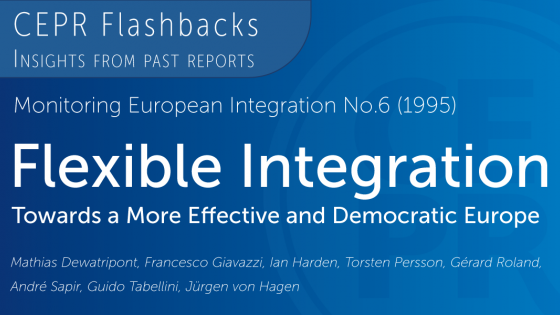Editor’s Note: This is the first “CEPR Flashback” – a new series of short Vox columns that highlight the current relevance of past CEPR reports. Since 1983, CEPR reports have often been ahead of the curve in anticipating and analysing problems in Europe and beyond. Looking back, it is clear that much of the analysis is still relevant and indeed helps put today’s challenges into context. This first Flashback’concerns the topic that EU leaders broached at the 60th anniversary of the Treaty of Rome – the Future of Europe.
The institutional challenges facing Europe
On 1 March 2017, the European Commission initiated a debate on the future shape of Europe with its “White Paper on the Future of Europe”. This envisions five scenarios for the way forward. At the heart of the matter is the ineluctable trade-off between integration and diversity – a trade-off that was the core concern of a CEPR report more than two decades ago (CEPR 1995).
The CEPR report introduced a line of reasoning that came to be known as "Flexible Integration”. At the time, the discussion was dominated by the notion of an “ever closer union”, or some sort of inner and outer core.
Written by leading scholars – Mathias Dewatripont, Francesco Giavazzi, Ian Harden, Torsten Persson, Gérard Roland, André Sapir, Guido Tabellini and Jürgen von Hagen – and drawing on the “theory of fiscal federalism”, the report argued that the EU should become a “club of clubs” where the clubs were defined along functional lines rather than national lines. It would not be an inner core made up of some members and an outer circle of other members. It would be more of a mix and match arrangement where the level of integration (beyond the base of the Single Market) would vary by area and by nation. Some of the most federalist nations might join all the deeper integration ‘clubs’ – say the common currency, Schengen and defence union – while others might only join some.
The goal of the authors was to find a way to "to close its democratic deficit and revive public support for the Union". They concluded that a policy of flexible integration would break the stalemate federalists and anti-federalists by satisfying the EU's essential policy goals - to make the Union’s legal structure more flexible and transparent, improve enforcement of the Single Market, achieve macroeconomic coordination outside the exchange rate mechanism, and make political decision-making more efficient and legitimate - but using cooperation through open partnerships in other areas.
Here is an excerpt from the 1995 Report.
The European Union faces difficult challenges: to go on with further enlargement; to reconcile radically different views on the appropriate scope and depth of integration; and to close the democratic deficit and revive public support for the Union. Written by a distinguished team of academics from six countries to inform public opinion before the 1996 Intergovernmental Conference, CEPR's sixth Monitoring European Integration Report argues for significant economic, political and legal reforms of the Union to meet these challenges. Flexible Integration is a model of reform designed to overcome the current stalemate between federalists and anti-federalists. lt introduces more flexibility to accommodate the heterogeneous interests in Europe without risking the gains achieved through past integration.
Flexible integration combines firm commitment by all members to a supranational common base - including a well-defined set of competences related to the Single Market - with optional integration in other areas through open partnerships. Within this framework, the report discusses a number of specific reforms, including: how to improve enforcement of the Single Market, making the four freedoms a reality; how to achieve macroeconomic coordination without the tarnished exchange rate mechanism, while accommodating the different views on the single currency; how to introduce a hierarchy of European Law, making the Union's legal structure more flexible and transparent; and how to make political decision-making more efficient and legitimate, representing and balancing different European interests and making decision-makers more directly accountable to the citizens of Europe.
References
Dewatripont, Mathias, Francesco Giavazzi, Ian Harden, Torsten Persson Gérard Roland, André Sapir, Guido Tabellini, Jürgen von Hagen (1995), Monitoring European Integration 6: Flexible integration, CEPR London


